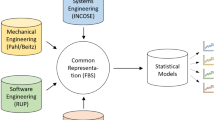Abstract
On the one hand, data models decrease the complexity of information system development. On the other hand, data models causes additional complexity. Recently structural analogies are discussed as instruments reducing the complexity of data models. This piece of research presents a procedure to identify structural analogies in data models and demonstrates its performance by analyzing Scheer’s reference model for industrial enterprises (Y-CIM-model). The proposed procedure is based on formalizing data models within set theory and uses a quantitative similarity measure. The obtained results show both identical and very similar information structures within the Y-CIM-model. Furthermore, ways of dealing with the identified structural analogies are discussed from an analysis and software design perspective.
Similar content being viewed by others
Literatur
Batini, Carlo; Lenzerini, Maurizio; Navathe, Shamkant B.: A Comparative Analysis of Methodologies for Database Schema Integration. In: ACM Computing Surveys 18 (1986) 4, S. 323–364.
Balzer, Wolfgang: Die Wissenschaft und ihre Methoden — Grundsätze der Wissenschaftstheorie — Ein Lehrbuch. Freiburg, München 1997.
Becker, Jörg: CIM-Integrationsmodell — Die EDV-gestützte Verbindung betrieblicher Bereiche. Berlin et al. 1991.
Becker, Jörg: Strukturanalogien in Informationsmodellen — Ihre Definition, ihr Nutzen und ihr Einfluß auf die Bildung der Grundsätze ordnungsmäßiger Modellierung (GoM). In: Wolfgang König (Hrsg.): Wirtschaftsinformatik ’95 — Wettbewerbsfähigkeit, Innovation, Wirtschaftlichkeit. Heidelberg 1995, S. 133–150.
Backhaus, Klaus; Erichson, Bernd; Plinke, Wulff; Weiber, Rolf: Multivariate Analysemethoden — Eine anwendungsorientierte Einführung. Berlin et al. 1996.
Becker, Jörg; Schütte, Reinhard: Handelsinformationssysteme — Domänenorientierte Einfü hrung in die Wirtschaftsinformatik. 2. Aufl., Frankfurt a. M. 2004.
Becker, Jörg; Schütte, Reinhard: Referenz-Informationsmodelle für den Handel: Begriff, Nutzen und Empfehlungen für die Gestaltung und unternehmensspezifische Adaption von Referenzmodellen. In: Hermann Krallmann (Hrsg.): Wirtschaftsinformatik ’97 — Internationale Geschäftstätigkeit auf der Basis flexibler Organisationsstrukturen und leistungsfähiger Informationssysteme. Heidelberg 1997, S. 427–448.
vom Brocke, Jan: Referenzmodellierung — Gestaltung und Verteilung von Konstruktionsprozessen. Berlin 2003.
Becker, Jörg; Schü tte, Reinhard; Geib, Thomas; Ibershoff, H.: Grundsätze ordnungsmäßiger Modellierung (GoM) — Sachbericht vom 23. März 2000. http://www-wi.uni-muenster.de/is/projekte/gom/Abschlussbericht/GOM_Schlussbericht.pdf, Abruf am 2004-12-09.
Chen, Peter Pin-Shan: The Entity-Relationship Model — Toward a Unified View of Data. In: ACM Transactions on Database Systems 1 (1976) 1, S. 9–36.
Corneil, D.; Gotlieb, C.: An efficient algorithm for graph isomorphism. In: Journal of the Association for Computing Machinery 17 (1970) 1, S. 51–64.
Conrad, Stefan: Schemaintegration — Integrationskonflikte, Lö sungsansätze, aktuelle Herausforderungen. In: Informatik — Forschung und Entwicklung 17 (2002), S. 101–111.
Ding, Ying; Foo, Schubert: Ontology research and development. Part 2 — a review of mapping and evolving. In: Journal of Information Science 28 (2002) 5, S. 383–396.
Elmasri, R.; Weeldreyer, J.; Hevner, A.: The category concept: An extension to the entity-relationship model. In: Data & Knowledge Engineering 1 (1985), S. 75–116.
Fettke, Peter; Loos, Peter: Referenzmodellierungsforschung. In: Wirtschaftsinformatik 46 (2004) 5, S. 331–340.
Ferber, Reginald: Dokumentensuche und Dokumentenerschließung. In: Peter Rechenberg; Gustav Pomberger (Hrsg.): Informatik-Handbuch. 3. Aufl., München, Wien 2002, S. 913–961.
Gamma, Erich; Helm, Richard; Johnson, Ralph; Vlissides, John: Design Patterns — Elements of Reusable Object-Oriented Software. Reading, MA, et al. 1995.
Hempel, Carl G.: Fundamentals of Concept Formation in Empirical Science. Chicago 1952.
Hevner, Alan R.; March, Salvatore T.; Park, Jinsoo; Ram, Sudha: Design Science in Information Systems Research. In: MIS Quarterly 28 (2004) 1, S. 75–105.
Hopcroft, John E.; Motwani, Rajeev; Ullmann, Jeffrey D.: Introduction to Automata Theory, Languages, and Computation. 2. Aufl., Boston et al. 2001.
Kalfoglou, Yannis; Schorlemmer, Marco: Ontology mapping: the state of the art. In: The Knowledge Engineering Review 18 (2003) 1, S. 1–31.
Kishore, Rajiv; Sharman, Raj; Ramesh, Ram: Computational Ontologies and Information Systems: I. Foundations. In: CAIS — Communications of the AIS 14 (2004), S. 158–183.
Loos, Peter: Geschäftsprozeßadäquate Informationssystemadaption durch generische Strukturen. In: Gottfried Vossen; Jörg Becker (Hrsg.): Geschäftsprozeßmodellierung und Workflow-Management — Modelle, Methoden, Werkzeuge. Bonnetal. 1996, S. 163–175.
Lyons, John: Semantik — Band I. München 1980.
Moog, Walter: Ähnlichkeits- und Analogielehre. Düsseldorf 1985.
Parent, Christine; Spaccapietra, Stefano: Issues and Approaches of Database Integration. In: Communications of the ACM 41 (1998) 5, S. 166–178.
Rahm, Erhard; Bernstein, Philip A.: A survey of approaches to automatic schema matching. In: The Very Large Database Journal 10 (2001), S. 334–350.
Remme, Markus; Scheer, August-Wilhelm: Konstruktion von Prozeßmodellen, Heft 125 des Instituts für Wirtschaftsinformatik im Institut für empirische Wirtschaftsforschung an der Universität des Saarlandes. Saarbrü cken 1996.
Rising, Linda: Pattern Mining. In: Saba Zamir (Hrsg.): Handbook of Object Technology. Boca Raton et al. 1998, S. 38–31 bis 38–39.
Rosemann, Michael: Komplexitätsmanagement in Prozeßmodellen — Methodenspezifische Gestaltungsempfehlungen für die Informationsmodellierung. Wiesbaden 1995.
Scheer, August-Wilhelm; Hars, Alexander: Extending Data Modeling to Cover the Whole Enterprise. In: Communications of the ACM 35 (1992) 9, S. 166–172.
Scheer, August-Wilhelm: 20 Jahre Gestaltung industrieller Geschäftsprozesse. In: Industrie Management 20 (2004) 1, S. 11–18.
Scheer, August-Wilhelm: Wirtschaftsinformatik — Referenzmodelle für industrielle Geschäftsprozesse. 7. Aufl., Berlin et al. 1997.
Schöning, Uwe: Theoretische Informatik kurzgefaßt. 2. Aufl., Heidelberg, Berlin, Oxford 1995.
Schü tte, Reinhard: Grundsätze ordnungsmäßiger Referenzmodellierung — Konstruktion konfigurations- und anpassungsorientierter Modelle. Wiesbaden 1998.
Seubert, Michael: Business-Objekte und objektorientiertes Prozeßdesign. In: Jörg Becker; Michael Rosemann; Reinhard Schütte (Hrsg.): Referenzmodellierung — State-of-the-Art und Entwicklungsperspektiven. Heidelberg 1999, S. 107–128.
Stegmüller, Wolfgang: Probleme und Resultate der Wissenschaftstheorie und Analytischen Philosophie, Band II, Theorie und Erfahrung, Zweiter Teilband, Theorienstrukturen und Theoriendynamik. Berlin et al. 1985.
Thalheim, Bernhard: Entity-Relationship Modeling — Foundations of Database Technology. Berlin et al. 2000.
Tversky, Amos: Features of Similarity. In: Psychological Review 84 (1977) 4, S. 327–352.
Ullmann, J. D.: An algorithm for subgraph isomorphism. In: Journal of the Association for Computing Machinery 23 (1976) 1, S. 31–42.
Wand, Yair; Weber, Ron: Research Commentary: Information Systems and Conceptual Modeling — A Research Agenda. In: Information Systems Research 13 (2002) 4, S. 363–377.
Winskel, Glynn: The Formal Semantics of Programming Languages: An Introduction. Cambridge, MA 1993.
Author information
Authors and Affiliations
Corresponding author
Rights and permissions
About this article
Cite this article
Fettke, P., Loos, P. Zur Identifikation von Strukturanalogien in Datenmodellen. Wirtschaftsinf 47, 89–100 (2005). https://doi.org/10.1007/BF03250981
Issue Date:
DOI: https://doi.org/10.1007/BF03250981




